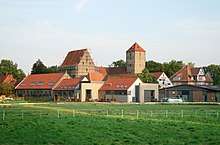University of Hildesheim
The University of Hildesheim (in German Universität Hildesheim) emerged from the Teacher's Training University of Lower Saxony (founded in 1946).
Universität Hildesheim | |
 Kulturcampus Domäne Marienburg | |
| Type | Public |
|---|---|
| Established | 1946 |
| President | Wolfgang-Uwe Friedrich |
Academic staff | 560 |
| Students | 7,500 |
| Location | , |
| Website | www.uni-hildesheim.de/ |
Description
The number of students enrolled has increased steadily since 2000 to approximately 7,500 in winter semester of 2015/16, of which 73% are female. Women also comprise 43% of the faculty, which is above the national average. Gender equality, and equal treatment for those from different social, ethnic and religious backgrounds, as well as educational integration in general, are important parts of the university's mission.
Interdisciplinary work, and narrowing the gap between theory and practice, are important components of the research and teaching profile. Its educational studies programs as well as cultural studies and applied linguistics are the traditional focus of the university. Additional study programs offered are in the fields of psychology, intercultural communication, environmental studies and business information/computer science.
Since 2003, the University of Hildesheim has been a foundation under public law, and therefore enjoys a comparatively high degree of autonomy. Among other things, it can award professorships and approve its own construction projects. Annual third-party funding has increased sevenfold since the foundation was created, and three major construction programs have followed (Main Campus, Marienburg Culture Campus and Bühler Campus), in addition to a number of other foundation projects and ten innovative endowed professorships. As a public foundation, the University of Hildesheim maintains close relationships with civil society, and a strong network of affiliation with educational, scientific and cultural institutions, as well as economic and business organizations.
Students are active partners in the teaching and learning processes, and they are encouraged to be involved in the development and improvement of teaching and study. Through its own scholarship programs (such as the College of Minerva and Lore-Auerbach Scholarships), the University of Hildesheim supports especially-capable and socially-committed students. Moreover, regular course evaluations show that a majority of students are “mostly satisfied” or “very satisfied” with their courses, and students particularly appreciate the engagement and commitment of the faculty. Accreditation reports have also noted the high level of teacher commitment and motivation among university faculty, as well as the personal atmosphere between students and professors.
Research Data Management
Research Data Management (RDM) is the process that encompasses all methods and procedures that are used to ensure the long-term usability of research data: generation, processing, enrichment, archiving and publication.
The service of Research Data Management is located in the Hildesheim University Library.
Methods and procedures of Research Data Management can be described in a data management plan. The University of Hildesheim Foundation recommends using the RDMO tool here. RDM is done “bottom-up”, i.e. always in cooperation with all departments and institutions. In February 2020, the university's guideline on handling research data was adopted. It promotes the transparency of science and research. Good data management ensures trustworthy and quality-oriented research within the discipline-specific and interdisciplinary standards and ensures an international exchange of current research in order to be scientifically connectable.
Data protection law and research ethical issues are always taken into account. Coffee Lectures are a format to teach RDM at the University Library Hildesheim for all four divisions (example poster).
Divisions
The university currently has four divisions:
- Educational and Social Sciences
- Cultural Studies and Aesthetic Communication
- Linguistics and Information Science
- Mathematics, Natural Sciences, Economics and Computer Science
Notable people
- Michael Gehler, historian
- Hans-Otto Hügel, specialist on popular culture
- Hanns-Josef Ortheil, author, scholar of German literature
- Eva Rieger (born 1940, Isle of Man), musicologist
- Sebastian Thrun, computer scientist
- Silvio Vietta, cultural historian
See also
- List of colleges and universities
- Hildesheim
References
External links
| Wikimedia Commons has media related to Stiftung Universität Hildesheim. |
- University of Hildesheim Website (in German and English)